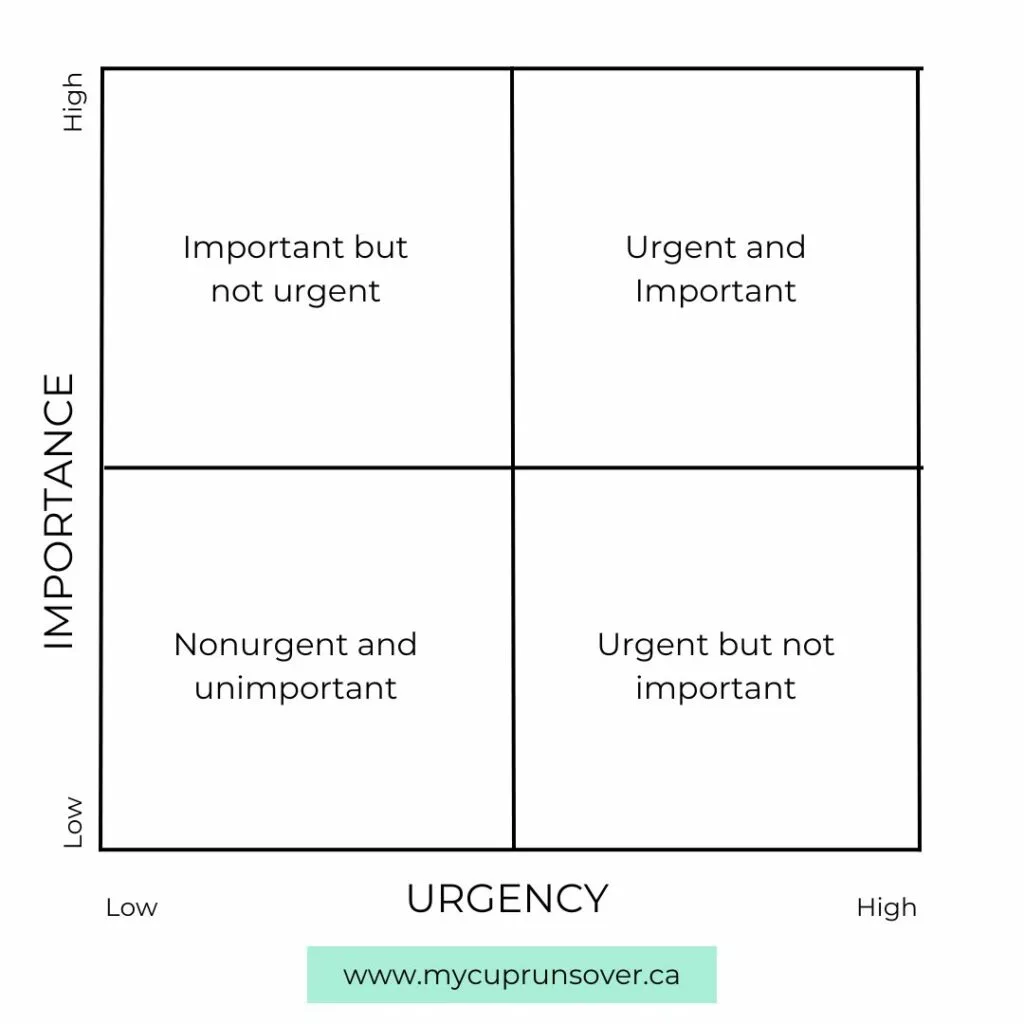As we enter the last quarter of the year, the goals we set for ourselves eight or nine months ago loom large. Whether we’ve gotten off track, pivoted, or chugged steadily toward our objectives, early fall is a fabulous time to revisit those goals and plan for the last quarter of the year. Even if you didn’t set specific annual goals at the beginning of the year, there’s no time like the present to start. In this post, I’ll show you how to set realistic quarterly goals for the last quarter of the year that will leave you feeling accomplished and set you up for greater success next year.

Affiliate disclosure: This post may contain affiliate links, which means we may receive a commission if you click a link and purchase something that we have recommended. Please read our disclaimer for more details.
The Importance of Quarterly Goal Setting
From traveling to furthering your education, from career moves to family planning, goal setting is a critical step in achieving the dreams you have for your life. But you may wonder why you need quarterly goals. If you have a 5-10-year plan and an annual plan, it might seem redundant to also track your goals by the quarter. On the contrary, it’s essential.
Annual goals don’t provide the granularity we need to get things done. They’re usually too big to take actionable steps on them without getting overwhelmed. Setting quarterly and monthly goals gives you focus and breaks your big goals down into manageable chunks that you can successfully tackle.
Quarterly planning in the last few months of the year is especially crucial for ending the year well. It gives you year-end focus and helps you close the gap between where you are and where you hope to be by the end of the year.
With three months left in the year, you still have time to make meaningful progress on your annual goals, even if you’ve gotten off track. This is the perfect time to recalibrate and adjust your strategy so you can focus on the most important things.
There’s also a certain amount of seasonal momentum naturally occurring in fall. The new school year is starting and many jobs and programs also begin around September so take advantage of this momentum to propel you toward setting and completing your final quarter goals. Doing so will set you up well for the new year—another natural time to reflect on your goals and establish new ones.
Reviewing Your Yearly Goals and Progress
Setting short-term goals increases your chances of success when it comes to achieving your annual and long-term plans. They break ambitious objectives down into smaller action steps that don’t leave you feeling overwhelmed.
The first step in deciding what your quarterly goals should be is looking at the big picture and seeing where you’re at with your annual goals. To do this, you’ll evaluate your annual goals and the progress you’ve made toward them, review key outcomes, and determine your focus areas for the final quarter.
Assessing Annual Goals: Evaluate Your Progress Towards Yearly Goals
Quarterly and monthly goals should always be made in the context of your broader annual goals. They are stepping stones designed to help you achieve more monumental objectives. The first step, therefore, in determining your quarterly goals is to evaluate your current progress on your annual goals.
If you’ve been keeping a progress journal for your goal tracking, spend an afternoon or a weekend reading through it and reflecting on what you’ve achieved so far. If you haven’t been doing this, now is a great time to start. Dedicate a fresh journal to tracking your goals and progress. Write about your setbacks, milestones, lessons learned, challenges, and insights.
If you’ve been using habit-tracking apps or other visual trackers, this is also a good time to review them. What habits have you developed? Where have you struggled? What do you want to adjust in the next quarter? Do you need harder goals or easier ones?
You may also want to get together with an accountability partner or a close friend and discuss your annual goals and the progress you’ve made so far. Working with someone can help you get clarity on what you need to do next to move further toward your goals.
Reflecting on Key Results: Review the Outcomes and Key Results Achieved
It’s helpful to use specific metrics to measure progress made on your goals. These metrics can be quantitative such as specific numbers, percentages, or deadlines, but they can also be qualitative. The latter might include feedback from others, impact made, or a self-assessment about your emotional or psychological state in relation to your goal (e.g. stress, happiness, fulfillment).
Whatever metrics you use, measure what you’ve achieved so far this year against your annual goals. Don’t worry if you aren’t where you hoped to be yet. Focus on both achievements and gaps. Notice your successes and your failures equally and celebrate any progress you have made.
Look at where you’ve been putting your resources (time, money, energy). Are they being used effectively? How could you reallocate them for greater efficiency?
Identify any bottlenecks or roadblocks that are holding you back. These could be external such as a lack of resources or support. They could also be internal, such as procrastination or a lack of clarity around your goals. Be honest with yourself and dig deep. The more you can uncover these answers, the better you’ll get at avoiding the things that hold you back.
Identifying Focus Areas: Determine Your Focus Areas for the Last Quarter
Once you’ve reviewed your year-to-date progress, the next step is to set your quarterly goals for the last quarter of the year. We’ll go into this in more detail in the next section, but here’s a brief overview of how you might do this.
1. Prioritize high-impact goals. If you have several goals remaining, you might have to prioritize and put some ahead of others. Focus on the ones that will make the greatest impact.
2. Break down complex goals. Larger goals should be broken down into smaller milestones that you can take action on each day or week.
3. Use the Pareto Principle. Twenty percent of the tasks, projects, or goals you’ve set for yourself will likely deliver about eighty percent of the returns in terms of impact and progress, according to the Pareto Principle. Focus on these tasks and goals. Be ruthless as you assess your bigger-picture goals and put each one to the test by asking how much of an impact it will have.
Setting SMART Goals for the Last Quarter
If you have studied goals in any depth, you’re almost certainly familiar with the concept of SMART goals. Most resources I’ve encountered on goal setting teach this method or something similar.
As a reminder—or a brief intro, if this idea is new to you—the most successful goals are those that are:
- Specific. You can clearly articulate the goal including specific targets.
- Measurable. You can use metrics (qualitative or quantitative) to track progress toward your goals.
- Achievable (sometimes noted as Attainable or Actionable). Your goals are within the realm of what is currently possible (or nearly possible) for you, given your current skill set and circumstances.
- Relevant. Your goals are aligned with your broader objectives.
- Time-Bound. You have deadlines to keep you on track.
For a more in-depth examination of SMART goal-setting, please see 50 Effective Goals to Set for Yourself This Year.
Aligning Personal Goals and Long-Term Vision
It’s important to set your personal and professional goals in tandem rather than compartmentalizing them, so you can create a balance and identify areas of overlap. Here are some tips for maintaining a balance between work-related and personal objectives:
- Set clear boundaries. Distinguish your work time and your personal time and keep them separate as much as possible.
- Time block for both. Integrate your calendars and make sure you’re chunking up your time in a way that gives you the space you need to achieve both your personal and professional goals.
- Find ways to merge goals. Are there skills that would serve you better in all areas of your life? Courses you could take that would help you achieve them? Are there financial goals that impact both work and home life? Look for areas of overlap to maximize efficiency.
- Schedule downtime and self-care. Plan to take regular breaks, get exercise, and sleep enough so you can be your best self as you pursue your goals. Make time for hobbies and important relationships to make sure you’re fueling your mind and spirit as well.
Identifying Personal Priorities
These exercises and prompts can help you identify your personal priorities if you haven’t done so already.
Life Wheel Exercise
Draw a circle and divide it into segments (like a pie chart) that represent different areas of life, such as:
- Career
- Home
- Relationships
- Health and Wellness
- Personal Growth/Education
- Finances/Travel
- Fun and Recreation
- Spirituality
Rate your satisfaction in each area on a scale from 1-10. Reflect on the scores and look for trends. Are there some areas that stand out as needing more attention? Perhaps these could become your next priority.
Prompt: Which areas of your life are most out of balance? What would make each area a “10”? How can you adjust your focus to bring more balance and satisfaction?
Vision Board Exercise
Create a visual representation of your ideal life using images, quotes, and words that inspire you. You can use the same life segments mentioned in the Life Wheel Exercise as inspiration. Keep your vision board visible and refer back to it often for inspiration and realignment.
Prompt: Look at your vision board. Which images or themes stand out to you? What do they represent in terms of your priorities? How can you incorporate these goals or themes into your life?
The Eulogy Exercise
Write a eulogy (or obituary) for yourself as if it’s been written by someone close to you at the end of your life. Highlight your key accomplishments and the overarching themes of your life—not as it is now, but as it would be if you lived your life to the fullest in every area that matters to you. This can be a life-changing tool that helps you get absolute clarity about your priorities, including how you want to be remembered and the impact you want to make with your life.
Prompt: What do you want to be remembered for? What legacy do you want to leave? Are your current goals aligned with this vision? If not, how can you change that?
Aligning with Long-Term Vision
After you’ve done these exercises, return to your long-term vision. Does it need to be updated to incorporate anything new that’s emerged for you as you contemplated your overarching vision for your life? Take the time to do that. It can be helpful to start with the long term (say, a 10-year plan) and then break it down into a 5-year plan and an annual plan.
Then, take the annual plan and break it down into quarterly milestones. What can you reasonably accomplish in the next three months to move the marker on your goals? Then, as you near the end of this quarter, repeat the process. Evaluate your successes and lessons learned and establish new goals for the ensuing season.
Identifying Focus Areas for Personal Development
Let’s look at some areas where you may want to set goals for growth and personal development.
- Identify key areas for growth. Start with a self-assessment of the different areas of your life such as skills, education, relationships, and self-care. Where are you thriving? Where do you feel unfulfilled or stagnated? What passions do you have that would significantly improve your well-being if you focused on them more?
- Skill and knowledge gaps. What gaps in your education, skills, training, etc. keep you from meeting your short or long-term goals? How can you close these gaps?
- Relationships and emotional intelligence. Which of your relationships are thriving? Which need more attention? What about your relationship with yourself? Setting time aside to practice mindfulness and restore or build relationships is a great idea for creating more fulfillment.
- Seek feedback from others. Ask trusted mentors, colleagues, friends, or relatives to help you look for patterns that might hold you back.
- Growth mindset. Do you have a mindset of continuous improvement? If not, ask yourself why? What limiting beliefs are you holding on to that aren’t serving you well? What would it take for you to believe that you’re capable of achieving the goals you’ve set for yourself? (Yes, even those audacious ones!) For more on developing a growth mindset, see Three Big Steps in Achieving Personal Development.
Effective Quarterly Goals Examples
By now, you probably have several specific goals to take you to the end of the quarter. But if you are struggling to figure out which smaller goals are reasonable to expect of yourself within a three-month timeframe, let’s look at some examples of effective quarterly goals.
Career Development
Break your career goals down by focus area and invest a small amount of time weekly in each area.
- Complete a certification. Obtain a professional certification relevant to your career, such as PMP for project management or a coding certification for tech roles.
- Increase networking. Attend at least three industry-related events or webinars and connect with ten new professionals in your field.
- Enhance skills. Master a new skill or software tool, such as advanced Excel functions or a new programming language, by completing an online course.
Personal Growth
Setting personal growth goals is a great way to maintain balance and not get overly focused on one area, such as your career. Even if your career is a top priority, it’s critical to continue pouring into the other areas of your life so you stay well-rounded and healthy.
- Develop a new habit.Establish and maintain a daily habit, such as 30 minutes of exercise or 15 minutes of meditation.
- Read more. Read three books related to personal development or another topic of interest.
- Improve communication skills. Enroll in and complete a public speaking or communication workshop.
Health and Wellness
Whether you have weight-loss goals, want to get stronger, or need to overhaul your diet, focusing on your health is an investment that always pays dividends. Being strong and healthy will serve you well in every area of your life. Try using a printable habit tracker to keep track of your progress in these areas.
- Fitness goals. Aim to achieve a specific fitness milestone, such as running 10 miles per week or attending 12 yoga classes.
- Healthy eating. Create and stick to a meal plan that includes at least five servings of fruits and vegetables daily.
- Sleep improvement. Develop a consistent sleep routine and improve sleep quality by tracking and adjusting sleep habits.
Financial Goals
Money is an essential goal-setting area for most people. It’s also an easy area in which to set measurable targets because money can, well, be easily measured. It’s easy to track whether you’ve stuck with your budget, saved as much as you planned, or increased your earnings and investments. Consider these factors as you set your own goals.
- Savings plan. Save a specific amount or set aside a percentage of your income into a savings or investment account.
- Budget management. Create and adhere to a detailed monthly budget, tracking all expenses and income to identify areas for improvement.
- Debt reduction. Pay down a certain amount of debt or make significant progress on a debt repayment plan.
Relationship Building
Though relationships often get overlooked, maintaining them is key to overall health and well-being. It’s easy to push them to the side in the busyness of life or let your other goals take priority, but you will never regret putting effort into your relationships.
- Reconnect with friends. Engage in meaningful conversations or meetups with at least three friends or family members.
- Enhance family time Plan a family activity or outing each month.
- Improve communication. Work on improving communication skills in your relationships by practicing active listening and open dialogue.
As you set your goals for the rest of the year, try not to take on too much. Choose a handful of goals, either from this list or that you identified in the previous step, and focus on those. Diluting your efforts too much is likely to create overwhelm and make it hard to achieve anything you set out to in the timeframe you’re aiming to.
Creating an Action Plan
At this point, you’ve looked at your goals for the entire year, evaluated your progress, identified the work you still need to do, and aligned your quarterly goals with your long-term plan. Phew! That was a lot of work. Take a moment to pause and congratulate yourself for putting in the hard work necessary to get that kind of clarity. It doesn’t come easily, but it’s so worth the effort.
And you’re almost there.
There are just a couple more things to think about as you set realistic goals for the last quarter of the year.
Prioritize
Earlier, we discussed the Pareto Principle and selected the tasks and projects that would have the greatest overall impact. If you haven’t analyzed your goals from that perspective yet, now would be a good time to do so.
Also, remember that you want to balance short-term urgency with long-term planning.

It’s easy to get caught up with urgent tasks, even the unimportant ones, to the detriment of those important things that are willing to quietly fall by the wayside. While some of your quarterly goals are stepping stones to your annual or long-term plans, others are essential for building positive habits or setting the foundation for future success. Make sure you’re incorporating both types of goals into your schedule and not just letting the urgent ones take over.
Track Your Progress
If you aren’t already, figure out how you will track your progress as you work toward your goals. Many tools and techniques exist to help you measure your monthly milestones and identify areas for adjustment.
You may want to experiment with:
- Journaling
- Bullet journaling
- Vision boards
- Spreadsheets
- Text documents
- Apps
Get started with bullet journaling
 |
 |
 |
| Rettacy Dotted Journal 2 Pack | Moleskine Classic Notebook, Soft Cover | Anecdote Hardcover Dotted Journal |
Avoid Overwhelm
When you set goals for yourself, it’s easy to become overwhelmed, especially if you aren’t following the SMART goals framework. To avoid overwhelm, follow these tips.
1. Divide and conquer. Remember to break your larger goals down into smaller, manageable tasks. Complete one task at a time before moving on to the next.
2. Prioritize. Again, make sure you’re giving your attention to the most important things (however you define that importance, which is not necessarily the same as how the World tells you you should define it).
3. Set realistic timelines. It’s tempting to be overly ambitious and take on way too many goals at once. While some people find this motivating, others find it overwhelming. Allocate enough time for each task and remember to build in margin, knowing that tasks almost always take longer to complete than we think they will.
4. Regular review and adjustment. Monitor your progress and make adjustments frequently. This helps you tune in to your goal-conquering style and develop a deeper understanding of what (and how long) it takes you to accomplish goals.
5. Get help. Ask for help from friends, relatives, and colleagues as you work toward your goals. Delegate when possible. Working with other people can reduce the burden of doing it all yourself and make the journey more enjoyable.
Preparing for the End of the Year
As we near the end of the year, it’s a natural time to take a closer look at your personal and professional life plans and honestly evaluate where you’re at.
Here are a few things to consider as you plan for the end of the year.
- Review your goals. Make a list of all the goals you set for the year. Review the specifics such as key performance indicators and desired outcomes.
- Assess progress. Gather the data you need to evaluate your progress. Compare your actual progress to your goals, noting what was achieved, what was partially finished, and what you didn’t get a chance to start on.
- Identify successes. Highlight the goals and milestones you accomplished.
- Analyze challenges. Look at obstacles and hindrances that kept you from achieving certain goals. Reflect on why that happened. What might you do differently next year to avoid these?
- Reflect on lessons learned. Which strategies and actions worked well? Which didn’t? Why? Which goals were you most excited about achieving? Which ones had the most impact? Which ones spurred you on to further actions or insights?
- Plan for the future. Set new goals for the upcoming year using the processes outlined above. (You may want to bookmark this post for future reference). Consider adjusting, expanding, or abandoning goals that were partially achieved this year.
- Celebrate achievements. Acknowledge and celebrate the success you saw. Treat yourself to something special, take a self-care day, or celebrate with family and friends. You may also want to document your achievements to give you future motivation and inspiration. This could take the form of a success journal or scrapbook, a vision board, a personalized gift, a small event, or a charitable donation.
Share Your Top Goal With Us
Setting goals is a challenging but oh-so-rewarding task that is essential for achieving the dreams we have for our lives. Yes, you have to put in a lot of work—dreaming up those dreams, breaking them down into long-term and short-term goals, figuring out what action steps will get those goals done, making time in your calendar, constantly readjusting and prioritizing—but it’s worth it. If you stay focused and committed to achieving your quarterly goals, you’ll absolutely start to see more progress, which will propel you forward toward achieving those overarching visions you hold dear. Leave a comment to let us know one goal you’re setting for yourself this quarter and the long-term goal it’s supporting. Just putting it out there for other people to see is an important step in manifesting it into reality.

Sophie Agbonkhese is a writer, homeschooling mother of four, and a recovering overachiever (who occasionally relapses). She is the founder of My Cup Runs Over, a site dedicated to helping busy women simplify and enrich their lives. When she’s not writing or debugging websites, Sophie spends her time reading, dancing, bullet journaling, reading, gardening, listening to audiobooks, and striving fruitlessly to have a clean house for at least five minutes.

